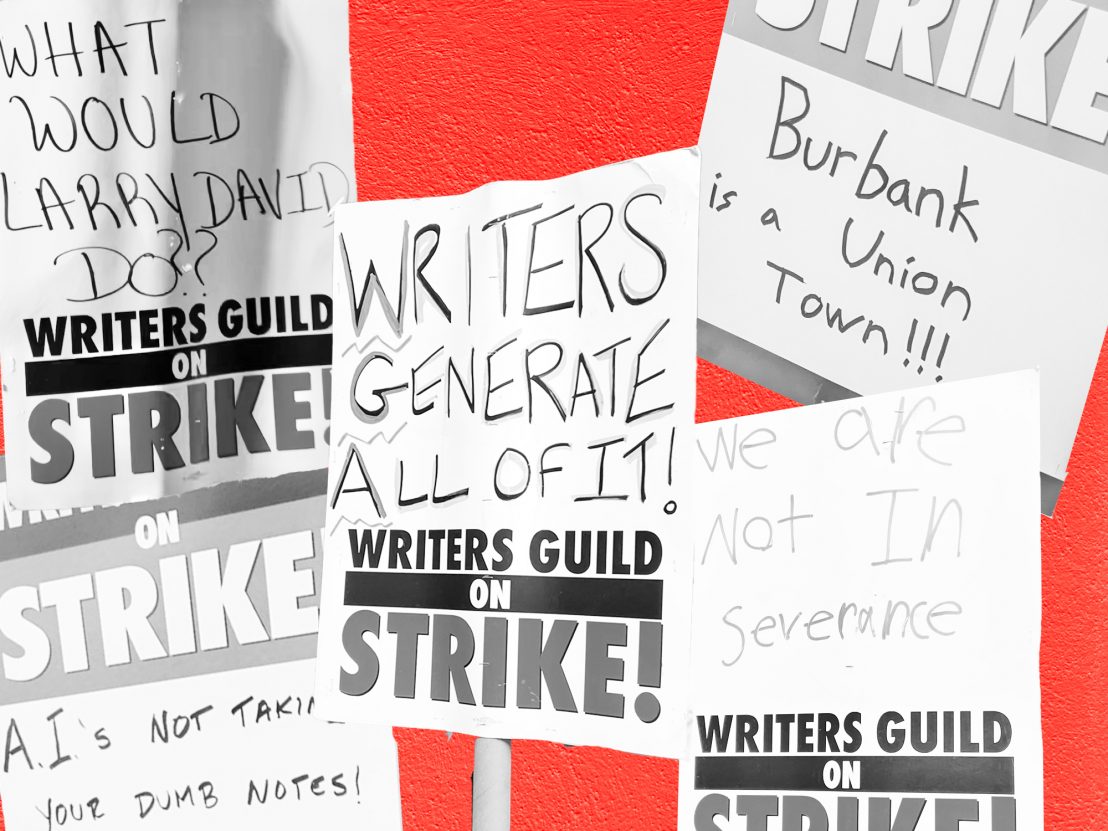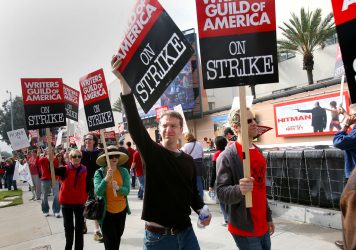
On Thursday 20th July the stars Christopher Nolan’s Oppenheimer walked out of their London premier. The American actors’ union SAG-AFTRA had voted to strike, and so members Cillian Murphy, Matt Damon, Emily Blunt and Florence Pugh were unable to continue promoting their film as part of industrial action. Until the dispute is settled, members of SAG-AFTRA will not act or promote their work on publicity tours or social media. They join members of the Writers Guild of America (WGA), who have been striking since 2nd May. A brave move, considering that Studio Executives have already said that they are willing to ‘starve out’ striking writers.
The walk-out was a significant moment that is now part of a very long history of striking and union activity in Hollywood. Despite the buzz around both Oppenheimer and Greta Gerwig’s Barbie (whose lead Margot Robbie has stated that she supports the strikes), promotion by actors can be crucial. Their opening weekend indicates that both films will probably be fine, but other upcoming releases may be impacted by striking actors. In fact, this is already happening; Luca Guadagnino’s latest Challengers has been pulled from Venice Film Festival as producers have pushed its release back to April 2024, citing the strike’s ‘parameters’ (member’s inability to carry out press tours) as the reason. The successes of past strikes tell us that they do, in fact, work, and so the unions’ demands for better pay and conditions in the streaming economy, as well as protection against AI tools for actors and writers, may actually be met.
SAG-AFTRA has existed in various forms, most recently as two separate organisations: the Screen Actors Guild and the American Federation of Television and Radio Artists. In 2012 they merged, because organisers found that studios were playing the unions off of one another as TV contracts and movie contracts were issued separately, and so their joint reserve fund for striking workers would be stronger.
SAG was founded in 1933 by actors Berton Churchill, Charles Miller, Grant Mitchell, Ralph Morgan, Alden Gay and Kenneth Thompson, who were fed up with the long hours that studios were putting their employees through. Four years later, the American Federation of Radio Artists was formed with 400 members, which later merged with the Television Authority to become AFTRA in 1952. The WGA was officially founded in 1954 and was cobbled together out of the Authors Guild, founded in 1912, and the Dramatists Guild of America, founded in 1921. This is all to say that union activity is practically built into the foundations of Hollywood, and that’s without mentioning the unions for costume designers, casting directors, location managers, agents, directors and many other film industry occupations. As writer Murray Ross put it in 1941, ‘“Hollywood is a union town.”
Over the years, industrial action by these unions has been semi-frequent and generally successful. An early example came in 1938 when AFRA, backed by stars like Bing Crosby and Jack Benny, bargained for a 125% wage increase for radio actors (yes, one hundred and twenty-five per cent). 1960 was a significant year for bargaining, and until 2023, the only time the WGA and SAG were on strike at the same time. The WGA were on strike for 153 days, whereas SAG were on strike for 43. Both had similar goals and the solidarity between them encouraged their collective opposition, the Alliance of Television Film Producers (ATFP), to meet demands on salary increases and the formation of pension, health and welfare funds for both unions.

Although the ideas of artificial intelligence and streaming may have seemed somewhat alien to former SAG and WGA members like Fred Astaire and Billy Wilder, they would certainly recognise the need to protect the unions’ members against exploitation as a result of them. A theme that runs across many strikes in Hollywood is the need for updated contracts as new technology changes the face of film and TV making. In the 1960 strikes, actors and writers negotiated for the establishment of pay for television reruns.
This was a relatively new concept established in 1955 by repeated broadcasts of I Love Lucy, made possible because it was produced on film and not kinescope, which became grainy if reused. In 1973 writers went on strike to demand guaranteed residual pay for movies on video cassettes and paid-for-television, a new watching concept that would experience huge growth later on that decade. This was revisited again in the actors strike of 1980 and the writers strike of 1981, as video tapes and pay TV were constantly growing and their pay was not being adjusted. Both the 1988 and 2007-2008 writers‘ strikes had a large focus on the sale of films and television shows to foreign markets and adjusting pay for these larger and more globalised markets.
For the current strikes, SAG-AFTRA have succinctly termed their demands as the need for a ‘modern contract for modern issues,’ meaning developments in A.I. that can see the likeness of actors used, and sufficient payment for streamed shows and films, which are not covered by the terms set out for reruns. ‘A modern contract for modern issues’ could also have been the tagline for any of the strikes mentioned above. Constant developments in technology and how viewers consume film and television has meant that the possibility for exploitation by the ATFP (the common adversary for modern Hollywood strikes) is a constant threat. Although stars like Margot Robbie and Matt Damon have an above-average wage, this is not true for thousands of SAG-AFTRA and WGA members who are victims to the gig economy and do not receive a huge paycheck for every project they work on. Solidarity from more established figures means that conditions for these members are more likely to improve during negotiations.
One feature of the current strikes is its strong focus on picketing, something that has not been a staple tactic of past industrial action. In recent weeks Daniel Radcliffe, Kevin Bacon, Mark Ruffalo and America Ferrera are just a handful of the familiar faces marching with protest signs in L.A. and New York. In the U.K., a solidarity protest was held by the British actor’s union Equity, with a rousing speech by Brian Cox on the danger of A.I. and the current residuals system, watched by the likes of Andy Serkis, Hayley Atwell, Naomie Harris and Simon Pegg, among others.
Despite the success of the 1960 writers and actors strikes, picketing was not encouraged by guilds because of the possible optics of being seen as extremely left-wing – which makes more sense when you learn that eventual Republican President Ronald Reagan was the president of SAG at the time. It also makes sense in the context of the previous years and the Hollywood ‘Red Scare’, in which the House of Un-American Activities investigated hundreds of Hollywood workers for possible Communist activity or ties, including Charlie Chaplin, Arthur Miller and Orson Welles. Reagan’s SAG cooperated in the investigations, providing names of members that were suspected of membership to the Communist Party. Hesitation around appearing ‘too left wing’ by picketing is understandable for the 1960 strikers, many of whom were likely to have been investigated. In the absence of the picket line, Elizabeth Taylor went on an extended vacation to Jamaica with her then-husband Eddie Fisher – although it is hard to imagine her battling with the elements and holding a protest sign aloft in support of her union.
Because of union activity, many Hollywood actors and writers have health insurance and pensions, as well as residual payments for television reruns and sales to foreign markets. Just as their forebears in the ‘60s, ‘70s and ‘80s have found, these past successes have not covered for the ever-developing beasts that are technological advancement and globalisation – SAG-AFTRA and WGA are now battling with streaming and A.I. But striking has worked in the past, and it can feasibly work again.
Published 26 Jul 2023

With the possibility of another strike looming, it's a good time to look back at the causes and impact of the notorious 2007-08 WGA revolt.

These talented women are fighting to give the film industry a feminine voice.

Reports suggest female-penned scripts hold the key to achieving gender equality.